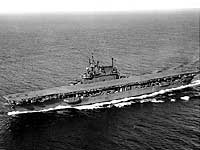
After beginning construction of the small fleet aircraft carrier Ranger (CV-4), the Navy revisited the issue of carrier design, as restricted by treaty. Ranger was clearly a very marginal ship, relatively slow, wholly unprotected against gunfire and torpedo attack, and with an unsatisfactory ability to operate aircraft in rough weather. A new design, displacing 36 percent more than Ranger's, was prepared that addressed all these issues. Two of these larger ships, Yorktown (CV-5) and Enterprise (CV-6), were ordered in Fiscal Year 1934, with construction beginning shortly before Ranger entered service. Completed in 1937 and 1938, these two carriers were satisfactory in most ways, and a slightly-modified third ship, Hornet (CV-8), was built under the Fiscal Year 1939 building program, after treaty restrictions had been effectively set aside by the outbreak of the European war. The Yorktown design also provided a basis for the Essex class, whose construction began in 1940 and continued through World War II.
In the mid-1930s, with treaty restrictions still very much in force, only enough carrier tonnage remained for another Ranger-sized ship. This became Wasp (CV-7), built under the Fiscal Year 1936 program. Though her design was an improvement over Ranger, Wasp suffered from the earlier carrier's inherent problems, most notably modest speed and no torpedo protection. Strictly a result of the limitations imposed by international agreement, she was the Navy's last serious attempt to build a small fleet carrier from the "keel-up", though an even smaller design, the Independence class, with greatly reduced aircraft capacity, was generated as a result of the World War II emergency.
Second World War combat experience confirmed pre-war expectations for these ship designs. Wasp's absence of anti-torpedo side protection doomed her to a blazing demise in September 1942, when a Japanese submarine's torpedo easily penetrated to her aviation fuel supplies. Two of the three Yorktown's were also torpedoed and lost, though both would probably have survived under better tactical circumstances. Their side protection schemes alongside the boilers proved not quite adequate to the threat, a weakness recognized when they were built but one that could not be addressed within the available tonnage, and the arrangement of their steam generating system clearly needed improvement. Both of these issues, and others, were satisfactorily addressed when the new Essex class was designed in the late 1930s.
The remaining ship, Enterprise served heroically through the World War II. Often damaged, she demonstrated a toughness and an ability to continue operating even when hurt, that confirmed the wisdom of adopting larger aircraft carrier designs. Though superceded by later ships and therefore not used after the war, she was widely regarded as a symbol of the great Pacific conflict. Under more favorable political circumstances, she would probably have become a memorial and survived to the present day.
The three ships of the Yorktown class were all
built at the Newport News Shipbuilding and Dry Dock Company, Newport News, Virginia. Individual ships' construction data follows:
Yorktown class "as-built" design characteristics:
The sole Wasp class carrier was built by the Bethlehem Steel Company at Quincy, Massachusetts. Her construction data follows:
Wasp's "as-built" design haracteristics:
This page features limited pictorial coverage of Yorktown and Wasp class aircraft carriers, with links to pages concerning individual ships.
For coverage of other classes of U.S. Navy fleet aircraft carriers, see: Fleet Aircraft Carriers -- Overview and Special Image Selection.
| If you want higher resolution reproductions than the digital images presented here, see: "How to Obtain Photographic Reproductions." |
Click on the small photograph to prompt a larger view of the same image.
|
Photo #: 80-G-428440 USS Ranger (CV-4) Underway at sea during the later 1930s. Official U.S. Navy Photograph, now in the collections of the National Archives. Online Image: 116KB; 740 x 610 pixels Reproductions of this image may also be available through the National Archives photographic reproduction system. |
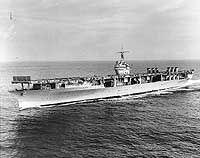 |
|
Photo #: 80-G-10786 USS Ranger (CV-4) Underway in Hampton Roads, Virginia, 18 August 1942. Note partially lowered after elevator and flight deck identification letters "R N G R" still visible just ahead of the ramp. Official U.S. Navy Photograph, now in the collections of the National Archives. Online Image: 154KB; 580 x 765 pixels Reproductions of this image may also be available through the National Archives photographic reproduction system. |
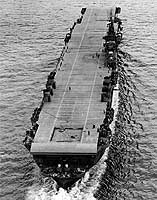 |
|
Photo #: 80-G-5132 USS Yorktown (CV-5) Anchored in a Haitian harbor, circa 1938-40. Official U.S. Navy Photograph, now in the collections of the U.S. National Archives. Online Image: 100KB; 740 x 535 pixels Reproductions of this image may also be available through the National Archives photographic reproduction system. |
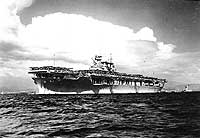 |
|
Photo #: 19-N-29688 USS Enterprise (CV-6) Photographed circa 1940, with TBD and SBC aircraft parked on her flight deck, aft. Photograph from the Bureau of Ships Collection in the U.S. National Archives. Online Image: 123KB; 740 x 620 pixels Reproductions of this image may also be available through the National Archives photographic reproduction system. |
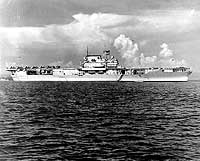 |
|
Photo #: 80-G-K-14254 (Color) USS Enterprise (CV-6) Operating in the Pacific, circa late June 1941. She is turning into the wind to recover aircraft. Note her "natural wood" flight deck stain and dark Measure One camouflage paint scheme. The flight deck was stained blue in July 1941, during camouflage experiments that gave her a unique deck stripe pattern. Official U.S. Navy Photograph, now in the collections of the National Archives. Online Image: 147KB; 740 x 600 pixels Reproductions of this image may also be available through the National Archives photographic reproduction system. |
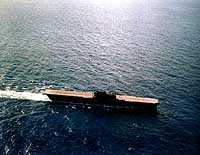 |
|
Photo #: 80-G-14866 USS Hornet (CV-8) Underway in the Southern Pacific, 15 May 1942, a week after the Battle of Coral Sea and the day before she was recalled to Pearl Harbor to prepare for the Battle of Midway. Official U.S. Navy Photograph, now in the collections of the National Archives. Online Image: 61KB; 740 x 595 pixels Reproductions of this image may also be available through the National Archives photographic reproduction system. |
 |
|
Photo #: 19-N-89185 USS Enterprise (CV-6) Making 20 knots during post-overhaul trials in Puget Sound, Washington, 13 September 1945. Photograph from the Bureau of Ships Collection in the U.S. National Archives. Online Image: 113KB; 740 x 580 pixels Reproductions of this image may also be available through the National Archives photographic reproduction system. |
 |
|
Photo #: USN 1036995 USS Enterprise (CVS-6) Awaiting disposal at the New York Naval Shipyard on 22 June 1958. She was sold for scrapping ten days later, on 2 July. USS Independence (CVA-62) is fitting out on the opposite side of the pier. Ships visible in the left foreground include (from front): USS DeLong (DE-684), USS Coates (DE-685) and USS Hoe (SS-258). Ten other destroyers are also present, as is a "Liberty" type ship. The Schaefer brewery is visible in the center background. Official U.S. Navy Photograph. Online Image: 149KB; 740 x 600 pixels Reproductions of this image may also be available through the National Archives photographic reproduction system as Photo # 428-N-1036995. |
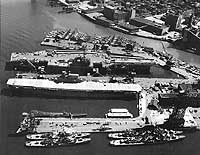 |
|
Photo #: 80-G-12240 USS Wasp (CV-7) Entering Hampton Roads, Virginia, on 26 May 1942. An escorting destroyer is in the background. Official U.S. Navy Photograph, now in the collections of the National Archives. Online Image: 107KB; 740 x 600 pixels Reproductions of this image may also be available through the National Archives photographic reproduction system. |
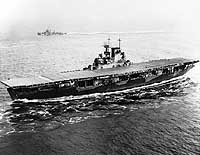 |
|
Photo #: 80-G-K-447 (Color) USS Wasp (CV-7) In port in June 1942, with a motor launch coming alongside. Probably taken in San Diego Harbor, California. Planes on deck, some with wings folded, include SB2U scout bombers and F4F-4 fighters. Official U.S. Navy Photograph, now in the collections of the National Archives. Online Image: 161KB; 740 x 610 pixels Reproductions of this image may also be available through the National Archives photographic reproduction system. |
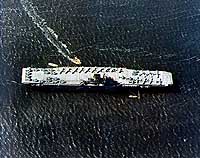 |
For more views of Yorktown class aircraft
carriers, see:
For more views of the only Wasp class aircraft
carrier, see:
For coverage of other classes of U.S. Navy fleet aircraft carriers, see: Fleet Aircraft Carriers -- Overview and Special Image Selection.
| If you want higher resolution reproductions than the digital images presented here, see: "How to Obtain Photographic Reproductions." |
Page made 6 November 2001